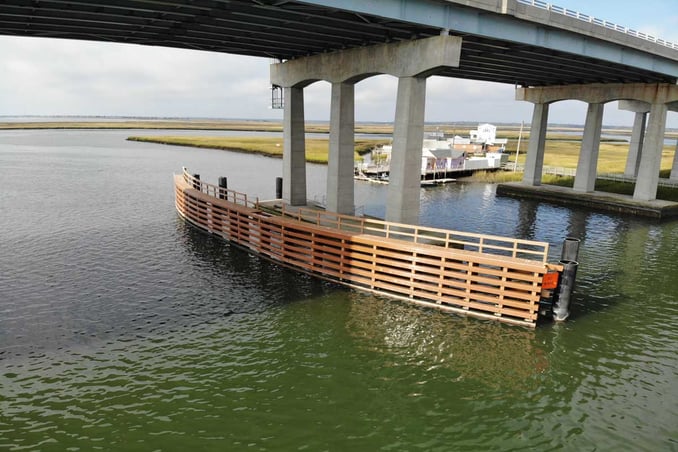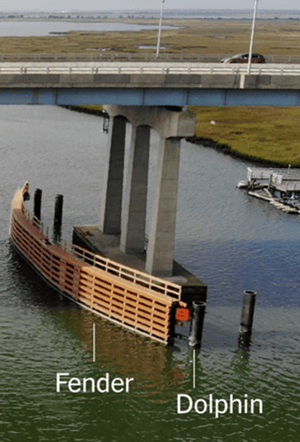
As the makers of bridge and waterway Fiber Reinforced Polymer (FRP) infrastructure products, we weren’t surprised when we started getting calls from reporters who wanted to understand “fenders” and “dolphins” after the accident on March 26th. There was no FRP protection products on the Francis Scott Key bridge and FRP was not appropriate for that maximum cargo vessel, but the press wanted to understand the types of structures that could have protected against a catastrophe like this and started calling companies with that level of expertise.
Many bridges in the United States lack protections like fenders and dolphins because, at the time of their design, the vessel size we see today simply didn’t then exist and the level of water traffic was much less. Engineers couldn’t plan for something they couldn’t know would come to be. But now that vessel and load sizes have increased, bridge protection measures are also changing.
Let’s look at the difference between fenders and dolphins and at the difference between the types of loads FRP versus concrete dolphins can take. For small- to medium-sized vessels like passenger boats and small commercial ships, FRP fenders and dolphins can protect bridge piers like bumpers in a bowling lane. But for large- and over-sized vessels like cargo ships and tankers, only huge, concrete dolphins or walls can provide adequate protection, like a shield blocking a blow from a gladiator. The protection and the vessel will be damaged in the collision, but the bridge and the public will be safe.
Terminology
- Dolphins: In the bridge and waterways infrastructure industry, dolphins do not refer to marine mammals. Dolphins are clusters of pilings or a large rock, steel or concrete structure that form a protective barrier unconnected to the bridge, a dock or any other structure. They’re often used for mooring or berthing but on bridges, they can be used as protective barriers, placed directly in front of bridge piers to prevent impacts.
- Fenders: Essentially a fence in the water, fenders funnel vessels between the bridge piers to prevent impact damage. These share a name with car fenders, as they serve a similar purpose: lessening a blow and attempting to redirect its impact.
- kip: A kip is a unit of force in United States standard measures used by structural engineers when normal pound-force isn’t efficient. A kip equals 1,000 pounds-force. The name is a combination of “kilo” and “pound.” Forces per unit may be expressed as kip/ft, which focuses on force by length, or kip/lb, which focuses on force by weight.
- Piers: Piers can refer to structures along waterways that stick out for shore-goers to enjoy or at which vessels may dock. But in the bridge industry, piers refer to the parts of bridges that go into the water. Piers are like the bridge’s legs/feet.
- Pilings: Human-made, vertical structures driven into the ground or marine floor and that stick up out of the water. For waterway infrastructure, pilings are used to guide vessels into port and, in clusters, support fenders or dolphins.
- Spans: These are the horizontal parts of bridges that vehicles and/or pedestrians travel across. Spans are what most people usually think of when they picture a bridge.
What FRP Fenders and Dolphins Do (and Don’t Do)
Fenders are often the most cost and structurally effective choice, but their effectiveness depends heavily on the waterway shape and bridge pier location.
Why FRP?
FRP is an engineered material. It’s not limited by nature and has been improved upon over time to give it the performance characteristics it now has. FRP materials rival the strength of grade 50 steel in bending but at a fraction of the weight. FRP’s modulus of elasticity—a measure of the ratio of stress to strain, describing a material’s ability to resist deformation—is considerably less than steel. FRP’s ability to take impact and absorb energy (sometimes called “work energy”), which is defined by the area under the load-displacement curve when the material is subject to bending loads (like an FRP fender being hit by a boat), is above that of steel, in some cases more than 10 times as much. FRP protection systems ‘bend, but don’t break.” FRP is designed to take the full energy of a hit and either stay standing or be the sacrifice that keeps the bridge itself standing.
In addition, inherently corrosion-resistant FRP will not rust or rot when exposed to water or salt. Wood, concrete and steel are all subject to degradation from water and brine. This shortens the material’s service life and requires more frequent maintenance and health checks to ensure adequate protection.
When FRP Fenders and Dolphins are Appropriate
 As a rule, FRP fenders are most effective for a smaller waterway that handles smaller vessels. For vessels with impact energies up to 3,000 kip/ft, 36-inch outside diameter (OD), heavy-wall FRP fenders and dolphins provide great protection. For example, these products are used for ferry terminal guide walls and impacted daily by automobile ferries carrying 70 cars are weighing 1650 tons.
As a rule, FRP fenders are most effective for a smaller waterway that handles smaller vessels. For vessels with impact energies up to 3,000 kip/ft, 36-inch outside diameter (OD), heavy-wall FRP fenders and dolphins provide great protection. For example, these products are used for ferry terminal guide walls and impacted daily by automobile ferries carrying 70 cars are weighing 1650 tons.
By adding a concrete cap to a large number of 36-inch OD FRP piles, a maximum of 20,000 kip/ft may be achieved, but even this would likely not stop a huge container ship moving at high velocity. For these cases—that is larger waterways that handle outsize ships—huge concrete dolphins or walls are often the most, if not only, appropriate solution.
What Concrete Dolphins Do
To fully protect any bridge from a massive impact, a large-diameter concrete dolphin or wall would be needed. They are also intentionally sacrificial, designed to withstand a major hit and take the full impact to protect the bridge they guard. The concrete dolphins can then be repaired or replaced as needed.
Baltimore, for example, added a power transmission tower system in the early 2020s that ran parallel to the Key Bridge, and the project included a large, closed-cell dolphin system to protect the grid. The stakes were too high for engineers to want to risk the grid in the event of an impact. The concrete barriers stand between essential infrastructure and any possible threat.
For further inquiries, please visit our newsroom.
